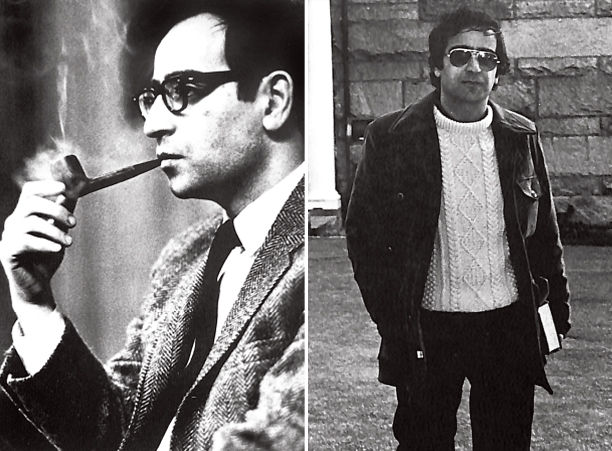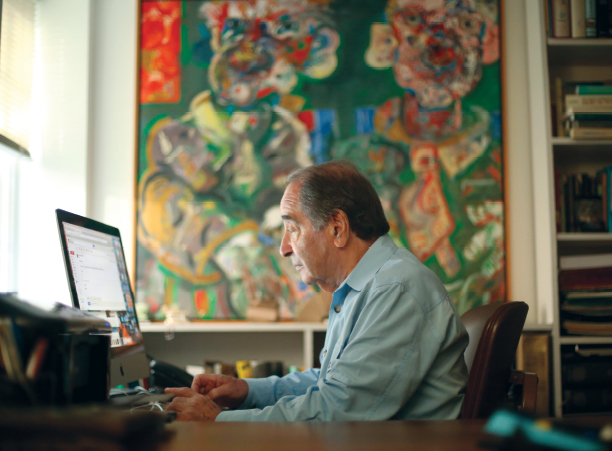department, recalls with a laugh. "So he said, 'Come down, let's have breakfast and have an interview.' I liked the idea of coming to a small, liberal arts college. My next best choice was a large university where I wouldn't be teaching upper division courses for a number of years, while Holy Cross was offering me the opportunity to teach in my specialty right away, as an equal partner."
He joined the English department in 1966, teaching courses on fiction, as well as 18th-century literature. Now beginning his 52nd fall on Mount St. James, Géracht has been both witness to and an active participant in years of the College's historic expansion and growth, impacting generations of students and colleagues not only inside his classroom, but far beyond its walls.
Géracht was the founder of the College's award-winning Study Abroad Program, which he directed for 18 years, in addition to his classroom duties. He has served on a multitude of College committees, including the one that drafted the institution's current mission statement, and also as a co-founding member of Interfaces, an award-winning, bilingual word and image journal.
In part due to his 30-year association and 19 years as editor of Interfaces, Géracht recently received a Chevalier dans l'Ordre des Palmes Académiques from the French government, in recognition of his promotion of the French language and culture in the United States. The award is the oldest non-military decoration in France, created by Napoleon in 1808.
Chevalier translates to "knight" in English, and the award dubs him a knight of arts and culture in France, a role he has also embodied for the Holy Cross community in his half century (and counting) on The Hill.
The Classic Teacher-Scholar
Margaret Freije, provost and dean of the College, says that one of the greatest gifts of a Holy Cross education is that faculty members are both teachers and scholars — there is no hard line between these two facets of academia at the College — and that Géracht's career embodies this connection.
"The teaching of our faculty members gets renewed by their scholarly interests and curiosity, and their scholarship gets renewed by their engagement with students. Maurice is a classic example of that," Freije says. "He asks, 'How do I take Henry James and make him accessible?' Maurice searches for the ways he can bring his students into conversation with texts that were written 200 years ago. That comes from his commitment to intellectual curiosity and his deep care for students."
The way Géracht cares for these students has evolved throughout his years at the College. "When I started teaching in the mid-'60s, I was their older sibling, that was the age difference. Then, over the years, the relationship changed," he says. "At this point, they're my grandchildren and I worry about them as a grandparent."
 Géracht over the decades on The Hill
Géracht over the decades on The HillAmong the generations of students that Géracht taught at Holy Cross was Edward P. Jones '72, the Pulitzer Prize-winning novelist and short story writer. "Maurice was the man who first alerted me to the fact that I had some writing talent and widened my understanding and appreciation of literature," Jones said upon Géracht's receipt of the Distinguished Teaching Award.
Today, Jones notes: "Maurice is one of about three professors I had who stays always in my mind. As a sophomore, Maurice, with his enthusiasm and devotion, introduced me to 19th-century British literature. We don't always know what the mind is absorbing when we are living our lives. But decades after college, the chapter subheadings in my novel were inspired by those in 'Vanity Fair,' one of the treasures Maurice used in my second year."
Julia Midland '14 met Géracht when she took the introductory course for English majors as a first-year student, and his passion and enthusiasm solidified her decision to become one. She went to Paris on a Maymester led by Géracht in the summer before her junior year.
"My summer in Paris under Professor Geracht's tutelage was truly a transformative moment in my life. He encouraged us to take advantage of the perks he had set up — including unlimited Metro rides and access to all of the museums in Paris with our student ID," she says. "I soaked these cultural destinations up like a sponge, and that's where I became really interested in museums and the role of arts and culture in cities. Upon returning, and inspired by the arts on our trip, I took up the studio art minor at Holy Cross, which was extremely rewarding, and set me on my journey to work in the arts space."
Today, Midland works for Beyond Walls, an arts nonprofit startup in Lynn, Massachusetts, that runs an annual mural festival and creates public art and cultural experiences in the city's downtown to promote increased feelings of safety and walkability. "Professor Géracht taught me more than how to write and study literature — he taught me how to constantly ask questions, seek new experiences, and never settle for less than what makes you happy," she says.
Freije says that Géracht is filled with the joy and enthusiasm that Midland spoke of, and that it infuses all areas of his life. He survived the Holocaust in German-occupied France during World War II, but does not often speak about the experience. "Part of his deep joy for life, his commitment to living to the fullest and his wide-ranging intellectual curiosity grow out of his own experiences as a child," she says.
Brittain Smith, Géracht's friend and successor as director of the College's Study Abroad Program, echoes Freije's assessment: "Maurice has a gusto for the good things in life, and that includes his great love of art and literature and music, his love of people and relationships, and also good food and wine — not for their own sake, but for what they bring to the fellowship of the table. You share a good meal with someone and so much comes up."
Smith recalls an evening when he stopped by Géracht's home to drop something off, and ended up staying for hours of conversation — and a perfectly prepared cheese plate that Géracht had whisked out of the fridge.
Thumbprints
Not content to enjoy arts and culture just in his spare time, Géracht works tirelessly to bring these experiences to Mount St. James for his community. James Kee, a professor emeritus in the English department and close friend of Géracht since the late 1980s, says that his colleague's commitment to visual arts is as great as his commitment to literature.
Géracht was instrumental in the donation of more than 700 works on paper by acclaimed American expressionist Robert Beauchamp to the Iris and B. Gerald Cantor Art Gallery at Holy Cross, and also orchestrated a recent Cantor exhibit of work by impressionist Gabrielle Thierry. This exhibit marked the first time that Thierry, most well-known for painting in front of Monet's Water Lilies at the Musée de l'Orangerie in Paris, showed her work in the United States.
 Maurice Géracht's work desk sits next to an oversized painting by famous American expressionist Robert Beauchamp, whose work Géracht was instrumental in bringing to Holy Cross. Photo by Patrick O'Connor
Maurice Géracht's work desk sits next to an oversized painting by famous American expressionist Robert Beauchamp, whose work Géracht was instrumental in bringing to Holy Cross. Photo by Patrick O'ConnorGéracht, who returns to France annually for the International Word and Image Conference and to visit family, is honored to have received the Chevalier award, but reflects on it with a humility that his colleagues say is his trademark.
"It puts into relief one aspect of my work, but I've also gotten an endowed chair, an award for editing and a Distinguished Teaching Award," Géracht says. "Now with this award — you've heard of double dipping — I feel like I'm quadruple dipping! All of that, the literature I teach and the art I bring and the scholarship I do, for me, it is all a piece on the same continuum. What I really do is teach how we learn. To have art on the walls as much as possible on campus and for students to read literature, it's a way of learning how to know."
It's an approach he brought to creating the College's groundbreaking, award-winning yearlong Study Abroad Program. In 1991, Géracht and colleagues established partnerships between Holy Cross and foreign colleges and universities, so students can directly enroll in those institutions and enjoy a completely immersive experience. He believes it is important that students spend the entire year abroad and study at partner universities so as not to replicate their American college experience.
"Long before immersion was a popular term, Maurice understood that study abroad has to be immersive, to take students out of the norm and put them in a place where they could live differently and experience the world in a different way, that takes some level of discomfort," Freije says. "That program is his brainchild and the fact that we end up No. 1 or No. 2 in the country for the number of students who study abroad for the full year is because of Maurice."
In 2017, Holy Cross ranked No. 1 on the Institute of International Education's list of colleges with long-term study abroad programs, the ninth year in a row that the College has held one of the top three spots. During the 2015-16 academic year that the list assessed, 133 Holy Cross students studied abroad for a year, which surpassed second-ranked Sarah Lawrence College by 58 students.
Géracht calls the Study Abroad Program one of his "thumbprints" around campus. Active on faculty committees throughout his career, he was also part of groups that brought the much-loved Cool Beans coffee shop to campus, and advocated for policies that allow junior faculty members to take sabbaticals for research — both "thumbprints" that he looks back on with pride. Another is his work on the College's current mission statement, which was adopted in the late 1980s. Kee served on the Mission Statement Committee with Géracht, and says his colleague's perspective as a Jewish man was invaluable in their work.
"The whole point of writing a mission statement at that time was to remain in continuity of the tradition of Jesuit and Catholic higher education, while also recognizing that profound changes had taken place over the 25 years prior," Kee says. "Maurice was articulate about the need to remain faithful to the tradition, and he did so, in part, because he is a survivor of the Holocaust. He had a kind of moral authority as someone who had seen the attempts to wipe out his tradition, and he kept reminding us of that. He did not want to see the school become more secular, but rather wanted to see it be as Catholic and as Jesuit as it could be, while still having an openness to the plurality of the world."
While Géracht refers to these "thumbprint" contributions humbly, quick to acknowledge the work of the group, Kee points out that Géracht's impact has been much more lasting than the splotch of a fingerprint.
"The thing that most amazes me when I think about Maurice's career is how many fronts on which he's made substantial contributions," Kee says. "The places where, if any of us had done one of those things, we'd be memorable figures in the history of the College, and he's done so many of them."
History on The Hill
Thanks to his long career, Gérchta has witnessed many of the College's most significant changes and seminal moments firsthand. He was there in the late 1960s when Rev. John E. Brooks, S.J. '49, vice president and dean, actively began recruiting black students to enroll in the nearly all-white male school. In 1972, Géracht saw Brooks, now president, champion coeducation and open the College to women, diversity-increasing moves the professor applauded.
"In many ways, I moved by staying in place," Géracht says when reflecting on his five decades on The Hill. "With each of these changes, it was like I worked at a different institution. The place, it changed continuously, in terms of its curriculum, in terms of the opportunities. When I first came to Holy Cross, there was no political science department or independent art department. The College really grew by leaps and bounds."
And without question, Géracht played a significant role in this growth, through his ability to build relationships, cultivate participation and develop opportunities.
"That's the thing about Professor Géracht, once he gets going, you get caught up in his enthusiasm and joy," said another Distinguished Teaching Award student nominator. "He sees every day as a gift and encourages you to do the same."
Written by Maura Sullivan Hill for the Fall 2018 issue of Holy Cross Magazine.
About Holy Cross Magazine
Holy Cross Magazine (HCM) is the quarterly alumni publication of the College of the Holy Cross. The award-winning publication is mailed to alumni and friends of the College and includes intriguing profiles, make-you-think features, alumni news, exclusive photos and more. Visit magazine.holycross.edu/about to contact HCM, submit alumni class notes, milestones, or letters to the editor.


